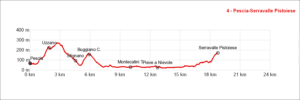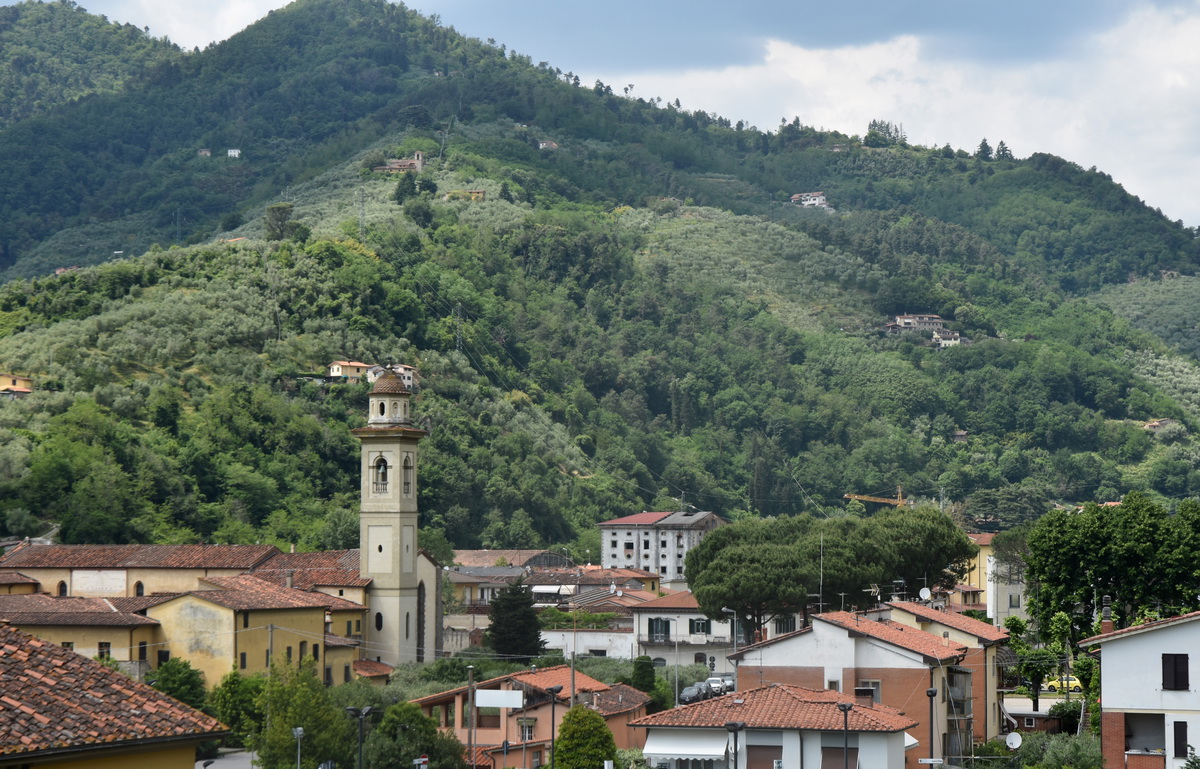Stage 4 – Pescia / Serravalle Pistoiese
FIRST HALF STAGE – From Pescia to Montecatini Terme – km 10,1
We wander up and down, through woods and olive groves, through the ancient villages that dominate the eastern part of the Lucca plain until we descend to the thermal area of Montecatini.
PesciaFrom Piazza Mazzini (km 0,0) reach the bridge that crosses the Pescia river and we cross to the higher side of the city, continuing on the right until we reach the Cathedral of Santa Maria Assunta. Continuing up the long the long and straight Via Giusti, we leave the area of the ancient village through the Fiorentina gate. Just beyond, we take the ancient Via Fiorentina to the left which, at its end, becomes a wide cobblestone from the Middle Ages, the ancient Via Mulattiera for Uzzano. The climb is really challenging and leads us quickly to gain altitude ending on an asphalted road. We continue to the right going up slightly for about 200 meters until we notice a small road that climbs to the left flanked by a guardrail. We soon cross a bridge obn the right and then continue between houses: the slope increases when we find the asphalt: 100 meters later we take a paved road to the right that climbs steeply until we reach the village of Uzzano (km 1.9). We enter through the Porta Nuova, go up until we reach the road that crosses the village and we follow it down to the right leaving through Porta delle Pille.
We are on a large square: we neglect the road that goes up to the left and the one to the right that goes down. Instead, we take the one that climbs in front of us to cut the hill (Via della Fonte di Maggino): the slope is not excessive and we easily reach the highest point of the stage (278 m). Here we see a small road that branches off to the right downhill and soon becomes a path, with a bumpy and steep surface at times. We skirt a wall that takes us to an asphalted road: above us the church of San Bartolomeo in La Costa. We cross the road and continue to descend on a path in the woods that leads us to a dirt road which, with a pleasant path among the olive trees, takes us to the upper part of the village of Stignano (km 4.6).
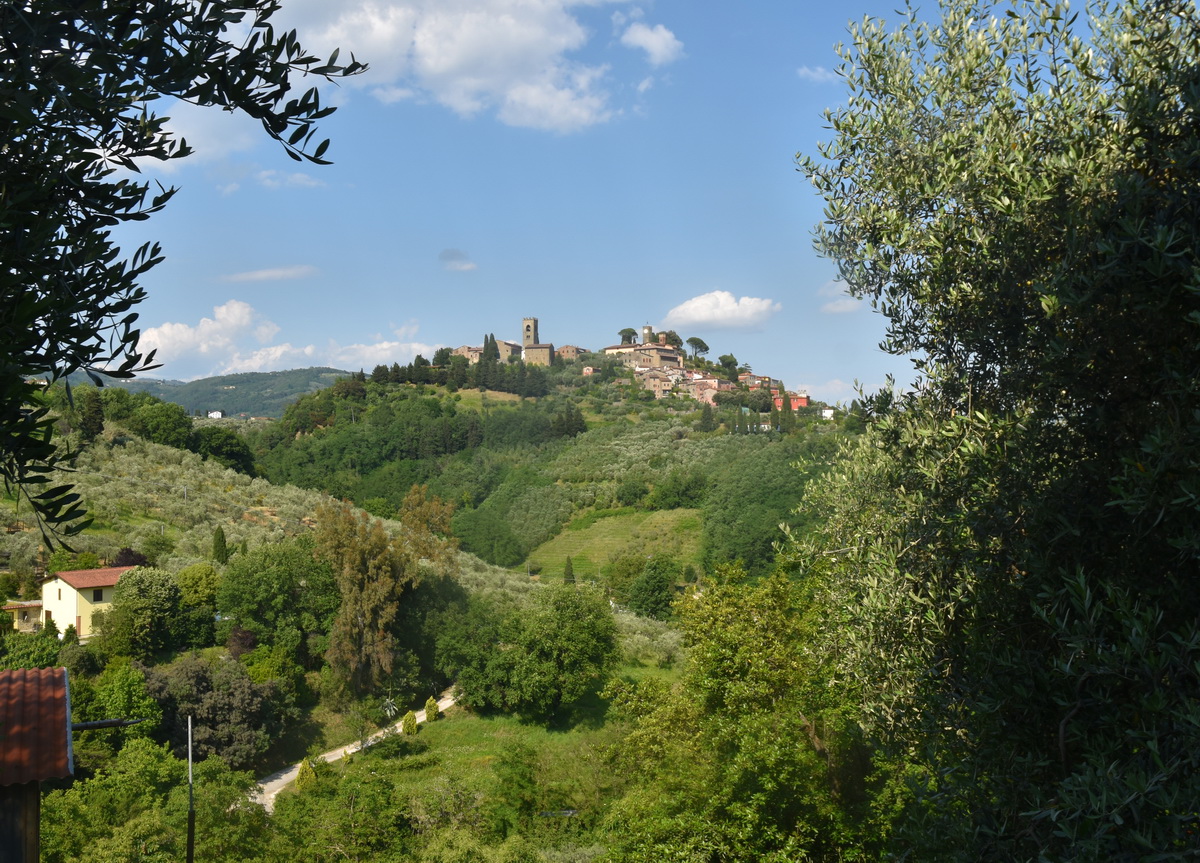
We go down via Puccini until a few metres before the stone gate to the village. We pay attention to the signs that lead us down to the left on a path that reaches the bottom of a canal: be careful because the first metres are steep and slippery. From this point the path goes downhill alongside the stream: currently (May 2021) a landslide prevents the passage. To pass, take the private road which, from the bottom of the canal, passes a little higher and which allows you to avoid the landslide (there is a sign with no passage but as long as there is a landslide there is no alternative!). We pass by an artificial lake and go down to the bottom of the valley. After the bridge we turn left and go up. Shortly after we meet an ancient medieval humpback bridge called “il Ponticino”. Further on we meet an ancient mill and, immediately after, we take to the right a track that climbs steeply, first in the woods and then among the olive trees, until we reach the first houses of Buggiano Castello (km 5.8). We laboriously climb the streets of the village until we reach the top where we find the church of the Madonna della Salute and San Nicolao. It is a great place to rest, also given the energy spent to get there!
Let’s go back a little and cross the central square overlooked by the praetorian palace whose facade is adorned with many coats of arms (it’s a pity that parked cars break the spell!). From the bottom of the square we go down through the houses of the village exiting through the solitary Porta di San Martino. We cross the provincial road going down on via Gavine; we pass a recent urbanization of villas until we reach the valley floor. At the end we turn left onto via Falciano: after 250 meters at a crossroads with a cypress in the center we turn right onto via Gamberaio.
At the end of the first straight we enter the park of Villa Ankuri on the right (owned by the USL 3 of Pistoia). We pass on the edge of a wood and leave the park reaching the public road. We take via Giuseppe Verdi and follow it to its end, then continuing to the right on via Vangile, which leads us to a large roundabout (Margine Coperta). The vast urbanized area of Montecatini has now begun, that we will leave after Pieve a Nievole, already in sight of Serravalle.
We bend to the left and follow via Primo Maggio, then via Lucchese, then Corso Roma which, with a straight path, takes us to the center of Montecatini (km 10.1) in the central Piazza del Popolo, a pedestrian area.
SECOND HALF STAGE – From Montecatini Terme to Serravalle Pistoiese – km 8,8
We leave the plain and go up the valley that leads us to Serravalle, perched on the hill that divides the plain of Lucca from that of Pistoia.
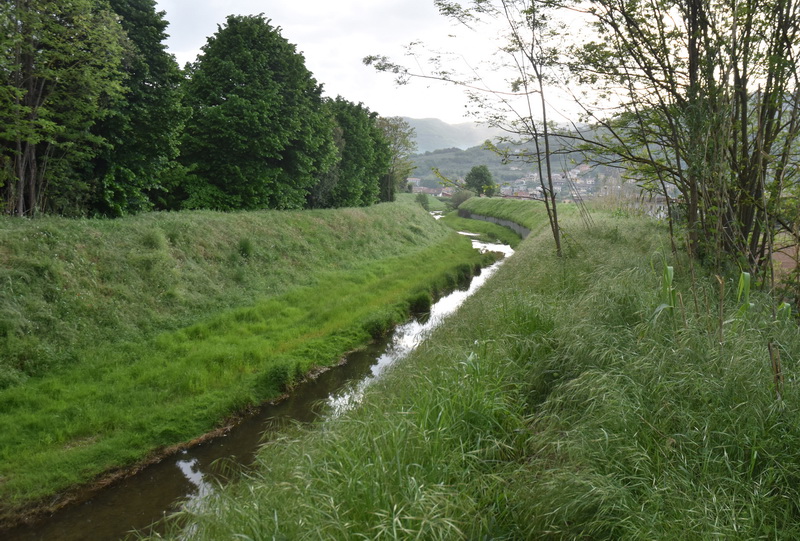
We walk along via Giuseppe Verdi in its entire length. Arrived at a wooded park, turn right and go to Viale Bicchierai. We walk along it to the right and after 50 meters we enter on the left to cross the kiosks of a market. At the end we turn right onto via della Salute and, after 300 meters, we turn left onto via Montebello which we follow to the end in Via San Marco. We bend a little to the right and enter to the left to cross a parking lot with trees to its end. After that we continue in the same direction on via Montebello (always the same!) Until its end: We find ourselves in front of a meadow: we cross it on the right side until we reach via Dalmazia. From here turn left for 50 meters and then right until you cross via Fanciullacci to then flow along via dei Pini. The urban fabric has not changed: however we have passed from the Municipality of Montecatini to that of Pieve a Nievole.
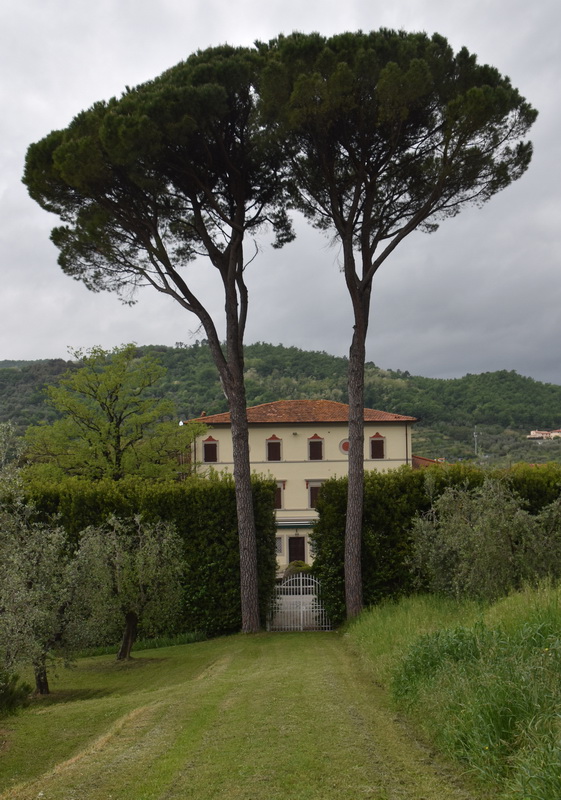
So let’s walk up to the end of via dei Pini; then we turn right until we arrive in Corso Matteotti, a road of great communication. We keep to the left side and, after less than 100 meters, we go up to the left on a ramp that takes us to the piazzetta XX Settembre. We take the narrow alley on the left and go around the block arriving in front of the parish church of San Pietro. Turning right again we find ourselves on Corso Matteotti. A few meters to the left we find piazza XXVII Aprile, the center of Pieve a Nievole (km 13.2). We cross it to find via Corrado Bonamici: we cross the railway, regulated by a level crossing, and we arrive on the Francesca state road. We arrive at the bridge over the Nievole stream and, on the other side, we finally leave the traffic and noise to walk on the quiet and pleasant embankment. [Attention: if the embankment is not practicable due to the grass that is too high, it is necessary to go down on the underlying via Fonda and follow it to the end, then continuing along via Ribocco: at the bottom we will find the path left].
The path on the embankment ends on state road 436: we follow it to the right until we reach the embankment on which the Florence / Pisa motorway runs. Before taking the underpass, turn left and walk along via del Poggetto, which soon becomes a dirt road, skirting the embankment. The highway will keep us company almost as far as Serravalle and we will cross it several times. We arrive straight up to a “hillock” (which gives the street its name) and we arrive at the top with a short climb into the woods. Here we use a footbridge to cross the highway. We turn left onto an asphalted road that runs, with very slight undulations, parallel to the highway for almost 600 meters and then goes to the other side with an underpass. We pass a hamlet and shortly afterwards we leave the small road to go up to the right on via Perticaia which leads us to go up to the Magione, an ancient hospitable now a restaurant. Above us the Serravalle motorway restaurant.
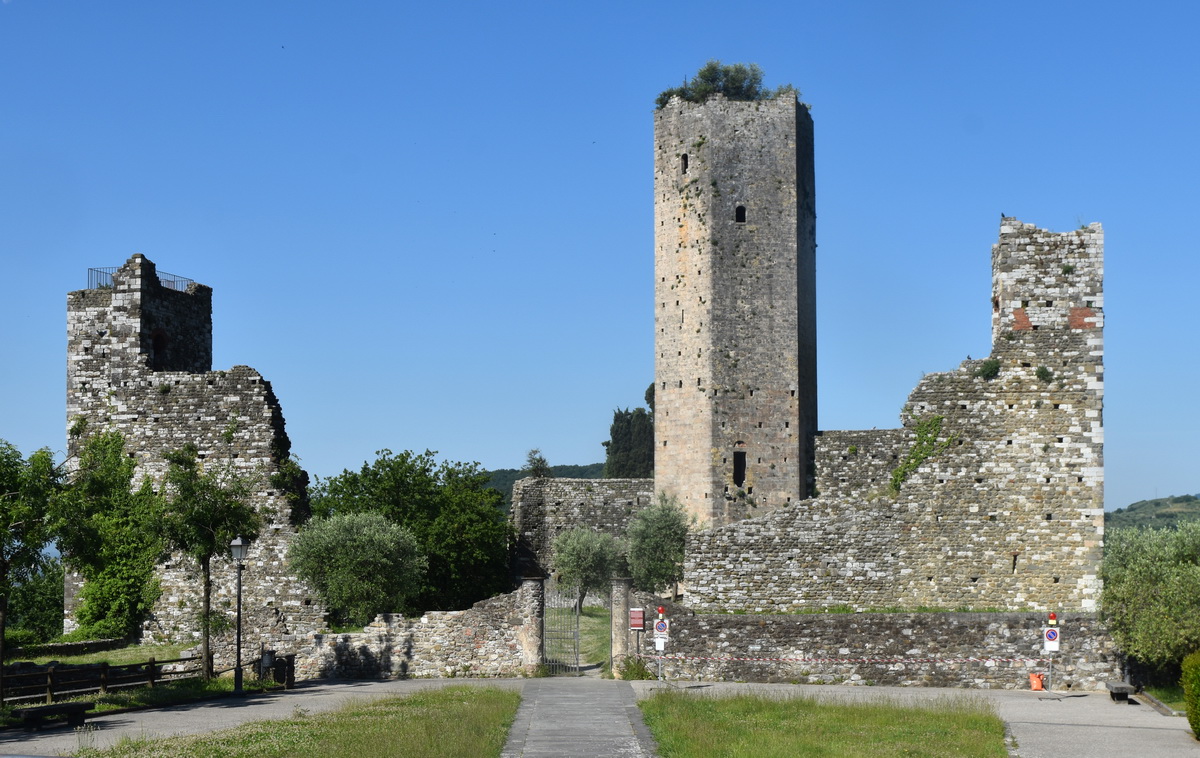
We go up again and, in a stretch of only 200 meters, we pass twice under the highway. There follows a stretch with a view of the small valley, in the midst of olive trees. Via Perticaia ends on via Lucchese, a very busy provincial road that we must follow, with great attention, for 200 meters; after a wide curve to the right we leave via Lucchese to take a small road on the left that will lead us to the village of Serravalle. We cross an ancient hamlet: we see a bottaccio for collecting the water used to feed the mills in the area. We are on via Gabella: the name recalls the ancient barrier gate where the toll was paid for transit. The climb that awaits us is demanding and leads us to reach the base of the three towers with difficulty which, from a distance, make Serravalle recognizable (km 18.9). The town, of medieval origin, is in an excellent position, full of light, medieval times and fresh air.
services
MONTECATINI TERME
Hotel Palladio (0.1 km from the walk) – Via Puglie, 42 – tel. 0572 72509 – info@hotelpalladiomontecatini.com Hotel Montebello – Via Montebello, 54 – tel. 0572 70076 – sales@hotelmontebello.it
SERRAVALLE PISTOIESE
Pilgrim hospitality Il Bucine – historic center. tel. 328.4688200 (Lodovica) – 6 places, bathroom – donation – BOOKING ESSENTIAL – Beautiful terrace overlooking the valley – Attention: the pizzeria is closed on Mondays and Tuesdays and there is no grocery store in the village but only a bar. Buy what you need before going up to the village!
La Magione Hotel and restaurant – Via Perticaia, 35 – info@lamagione.it – tel. 0573 518066 – 335 7017867 (Maurizio) – Ancient Templar mansion where you can dine and stay overnight
Borgo a Buggiano
Trenitalia - Pistoia - Lucca - Pisa line
Blubus Copit Pistoia - lines 701 and 703 Pescia Station - Montecatini Station.
Montecatini T.
Trenitalia - Pistoia - Lucca - Pisa line
Blubus Copit Pistoia - lines 701 and 703 for Pescia Stazione
Blubus Copit Pistoia - line 73 to Monsummano.
Taxi - parking on the square in front of the train station.
Monsummano T.
Montecatini Terme railway station also serves the Monsummano T.
Blubus Copit Pistoia - line 53 and line 63 for Serravalle Pistoiese, Pontelungo and Pistoia
Blubus Copit Pistoia - line 73 for Montecatini Terme and Pescia
Pharmacies: Uzzano, Borgo a Buggiano, Montecatini T., Monsummano T., Serravalle P.
H0spital: Pistoia
Bar: Uzzano, Buggiano Castello, Borgo a Buggiano, Montecatini T., Monsummano T., Serravalle P.
Restaurants: Uzzano, Buggiano Castello, Borgo a Buggiano, Montecatini T., Monsummano T., Serravalle P.
Bank: Uzzano, Borgo a Buggiano, Montecatini T., Monsummano T., Serravalle P.
Post Office: Uzzano, Borgo a Buggiano, Montecatini T., Monsummano T., Serravalle P.
Railway station: Montecatini center, Montecatini Terme, Masotti station
Sporting equipment: Montecatini T.
Food and Supermarket: Uzzano, Borgo a Buggiano, Montecatini T., Monsummano T., Serravalle P.
Mechanical assistance service for bicycles: Montecatini Terme, Pieve a Nievole
For the stretch from Montecatini to Serravalle Pistoiese you can call:
– Lodovica 328.4688200
– Paolo 348.3326624
places
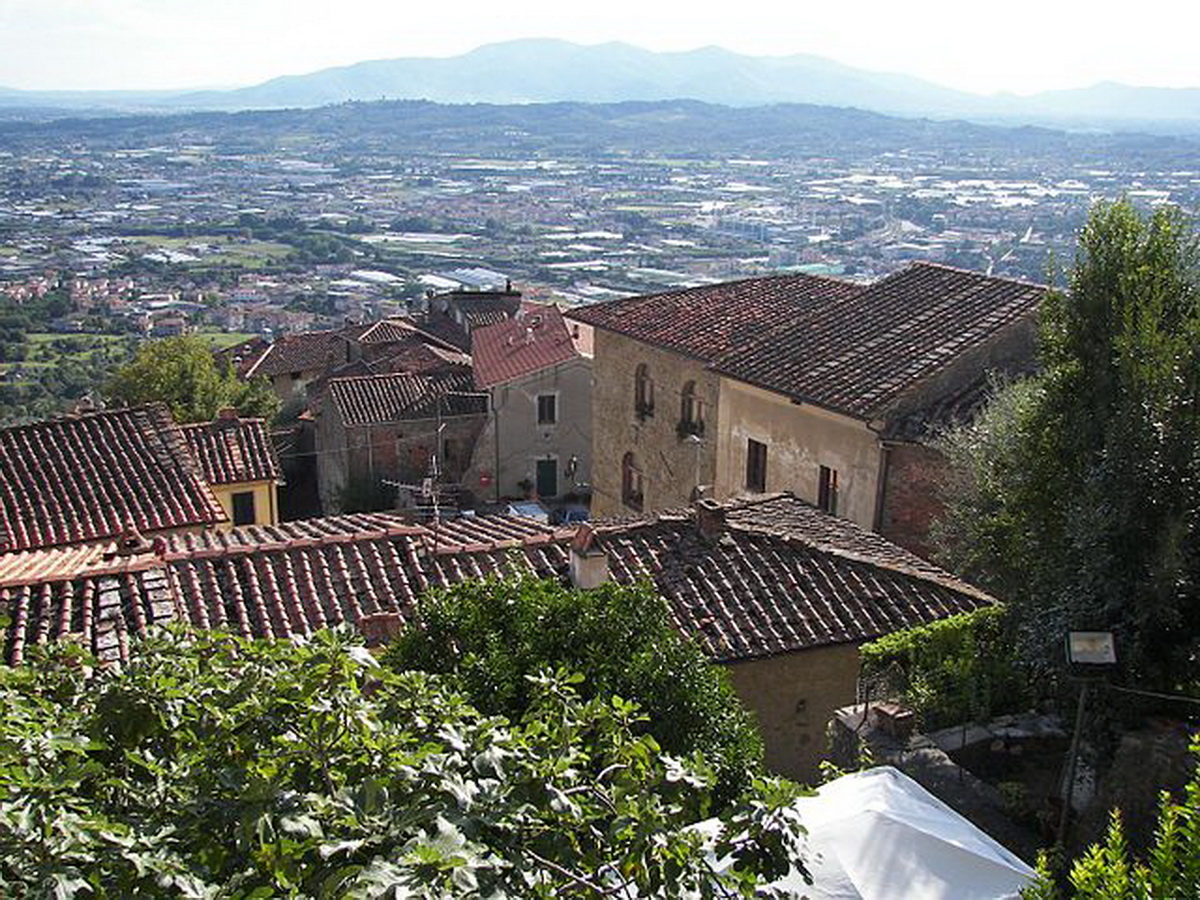
We are in the heart of Tuscany, in a strategic position that over time has allowed the control of the underlying plain; here, in the north-western part of the Valdinievole on a small hill stands the medieval village of Uzzano Castello. The village, perched on the hill covered with olive trees, thanks to a suggestive lighting shows its ancient charm even at night, with a triangular urban layout, the top of which is marked by the area of the ancient Rocca. Several sacred places and palaces tell its story: the Oratory of Sant’Antonio da Padova, the Oratory of the Madonna del Canale, the Palazzo del Capitano del Popolo and the ancient church of Santi Jacopo and Martino and the Oratorio della Misericordia which overlooks the entire valley. The castle seems to date back to the Longobard period. In this area, favored by the route of the Via Cassia-Clodia, various places of rest and shelter were built for wayfarers and pilgrims who in the Middle Ages were numerous along the nearby Via Francigena. Our path leads out of the village, and after about a couple of kilometers, we arrive at the Costa di Uzzano where we find a beautiful Romanesque church dedicated to Saints Bartolomeo and Silvestro and an amazing viewpoint.
The hamlet of Sant’Allucio saw the foundation of the first free hospice for pilgrims and foreigners opened on the Via Cassia-Clodia. Hallucio is today the patron saint of Pescia and his remains are preserved in the Cathedral.
For more information: https://it.wikipedia.org/wiki/Sant’Allucio
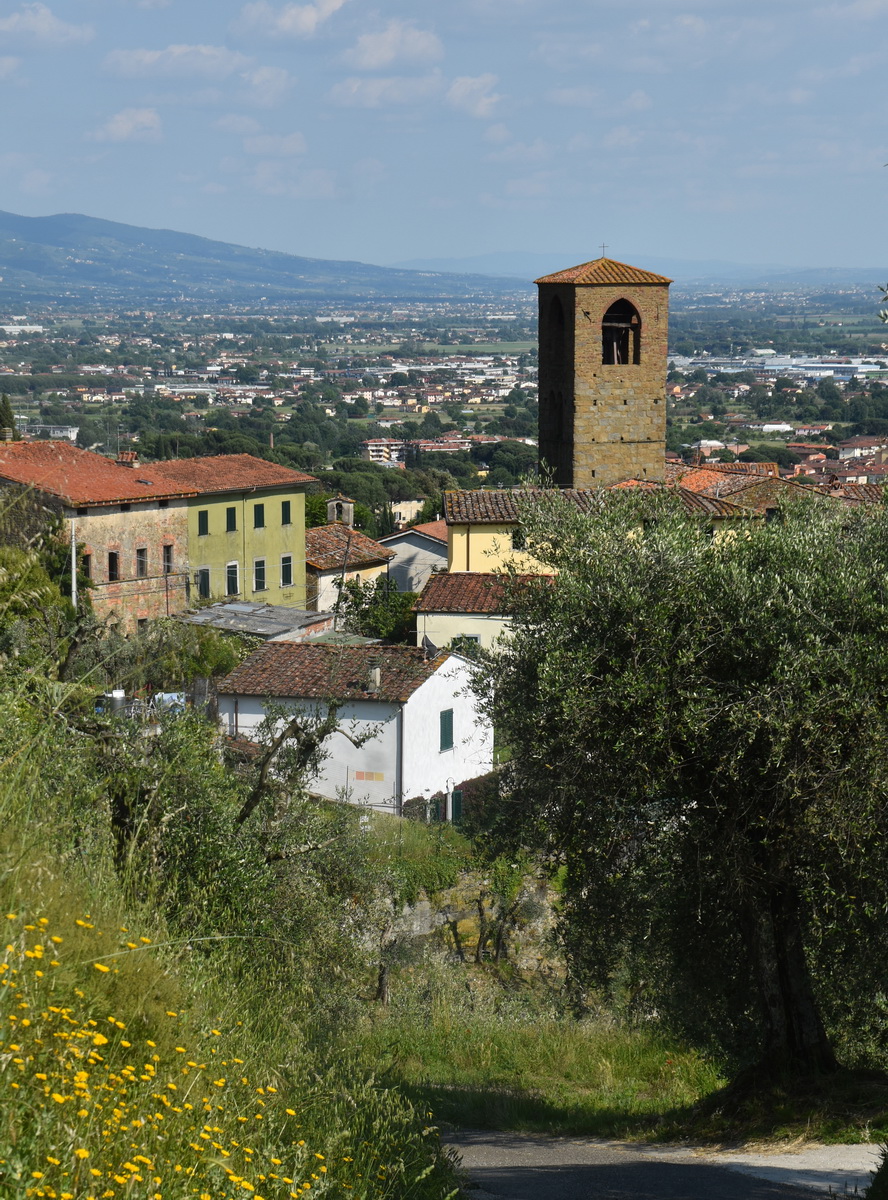 The small hamlet houses a beautiful parish church, the Church of S. Andrea, dating back to the 11th century, inside which, with a single nave, fragmentary frescoes from the 14th century are preserved, a marble stoup from 1540 and a baptismal font, also in marble, dated 1613. Immersed in olive trees, Stignano gave birth, in 1331, to Coluccio Salutati, one of the initiators of humanism, chancellor of the Municipality of Florence. He is considered one of the most important men of government between the end of the 14th and the beginning of the 15th century. For thirty years he was Chancellor of the Republic of Florence where he played a very important diplomatic role in curbing the ambitions of the Duke of Milan Gian Galeazzo Visconti, who wanted to create a state including central-northern Italy. He elaborated his doctrine of Florentine libertas and played an important role in the spread of Petrarchian and Boccaccio’s humanism, becoming the most important exponent of the first generation of humanists. The Duke of Milan G. Visconti claimed to receive more damage from Coluccio’s letters than from the weapons of the Florentines with whom he was at war or from an army of 20,000 soldiers.
The small hamlet houses a beautiful parish church, the Church of S. Andrea, dating back to the 11th century, inside which, with a single nave, fragmentary frescoes from the 14th century are preserved, a marble stoup from 1540 and a baptismal font, also in marble, dated 1613. Immersed in olive trees, Stignano gave birth, in 1331, to Coluccio Salutati, one of the initiators of humanism, chancellor of the Municipality of Florence. He is considered one of the most important men of government between the end of the 14th and the beginning of the 15th century. For thirty years he was Chancellor of the Republic of Florence where he played a very important diplomatic role in curbing the ambitions of the Duke of Milan Gian Galeazzo Visconti, who wanted to create a state including central-northern Italy. He elaborated his doctrine of Florentine libertas and played an important role in the spread of Petrarchian and Boccaccio’s humanism, becoming the most important exponent of the first generation of humanists. The Duke of Milan G. Visconti claimed to receive more damage from Coluccio’s letters than from the weapons of the Florentines with whom he was at war or from an army of 20,000 soldiers.
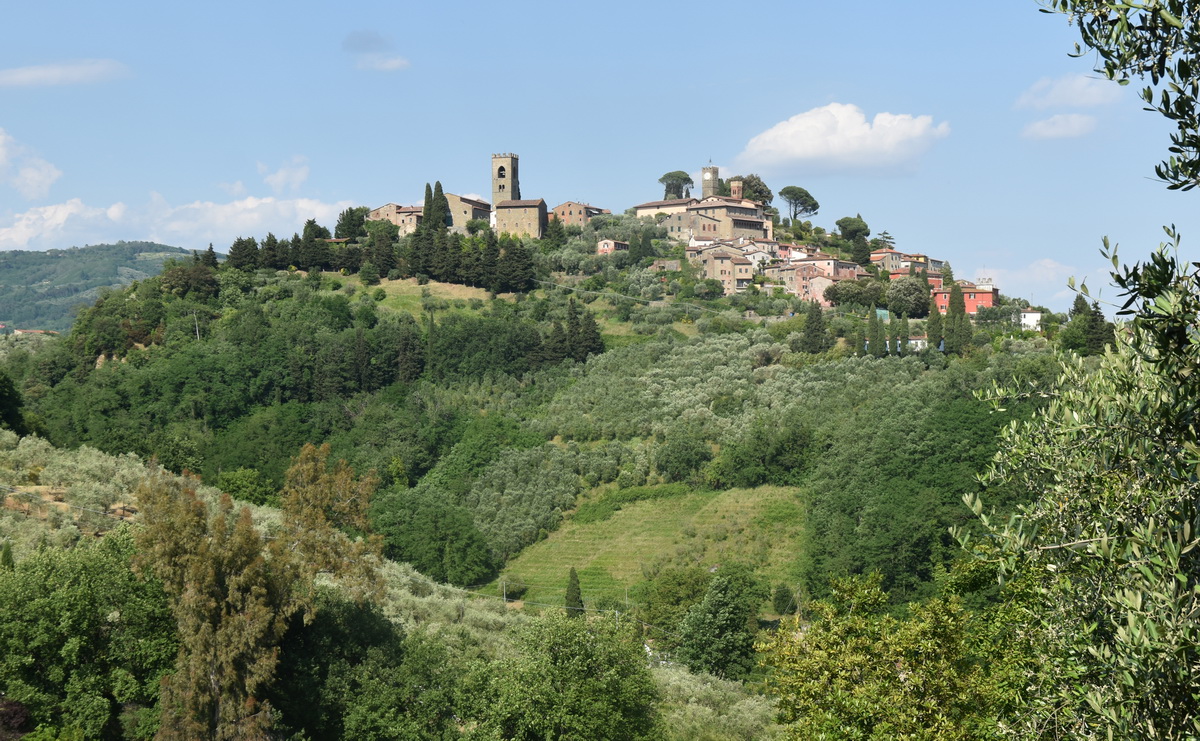 It is a medieval village inhabited by just over a hundred people that hides ancient stories and atmospheres of the past behind its walls. You reach the Piazza Pretorio, at the top of the hill, through the characteristic alleys. The marvelous façade dotted with the emblems of the various families that have succeeded each other over the centuries indicates the fourteenth-century Palazzo Pretorio inside which there are frescoes of the fifteenth century. Right next to it is the Romanesque church of San Nicolao dating back to the 11th century, with three naves, with a baptismal font and pulpit. From the small garden behind the church you can enjoy a great view of the valley. Walking along the alleys you can see wonderful private gardens, called “secrets”, in which lush citrus trees grow, thanks to a particular microclimate enjoyed by the village. Every two years an event is held in which the gardens are opened and shown to visitors, in a kind of competition, guests are welcomed with music, themed foods, and the scents of flowers.
It is a medieval village inhabited by just over a hundred people that hides ancient stories and atmospheres of the past behind its walls. You reach the Piazza Pretorio, at the top of the hill, through the characteristic alleys. The marvelous façade dotted with the emblems of the various families that have succeeded each other over the centuries indicates the fourteenth-century Palazzo Pretorio inside which there are frescoes of the fifteenth century. Right next to it is the Romanesque church of San Nicolao dating back to the 11th century, with three naves, with a baptismal font and pulpit. From the small garden behind the church you can enjoy a great view of the valley. Walking along the alleys you can see wonderful private gardens, called “secrets”, in which lush citrus trees grow, thanks to a particular microclimate enjoyed by the village. Every two years an event is held in which the gardens are opened and shown to visitors, in a kind of competition, guests are welcomed with music, themed foods, and the scents of flowers.
This is the valley of the Cessana stream (formerly called Standipesce), which crosses landscapes of particular historical and environmental value: the stream flows in a deep valley characterized by a rich biodiversity of the banks, with black alders, elders, ferns, sedges, and pulmonary plants.
This town deserves all the attention and offers many historical, artistic, customs and Italian culture insights. The history of its thermal town begins in the second half of the eighteenth century; the Grand Duchy of Tuscany was presided over by the Grand Duke Pietro Leopoldo who played an important role in the history of Montecatini by starting the reclamation works in the Valdinievole area, fundamental for the development of the city which at the end of the 18th century was structured along large tree-lined avenues that we see today again. At the beginning of the twentieth century it definitively acquired the role of a prestigious thermal town; with the construction of large hotels and structures related to leisure and relaxation. At the beginning of the twentieth century the style that is most popular is the one called Liberty which, as we will say later, in this town finds splendid and elegant representations. Although in recent times thermal tourism has undergone a strong downsizing, in Montecatini Terme you will find everything you need for a fun and relaxing holiday. Ancient and elegant spa facilities, clubs, restaurants and discos, shopping in the streets of the center and numerous events that take place throughout the year, especially on weekends. A stone’s throw from the railway station, Piazza del Popolo is the main one; viale Verdi originates from this, a wide tree-lined avenue, along which the main monuments and spa facilities of Montecatini line up.
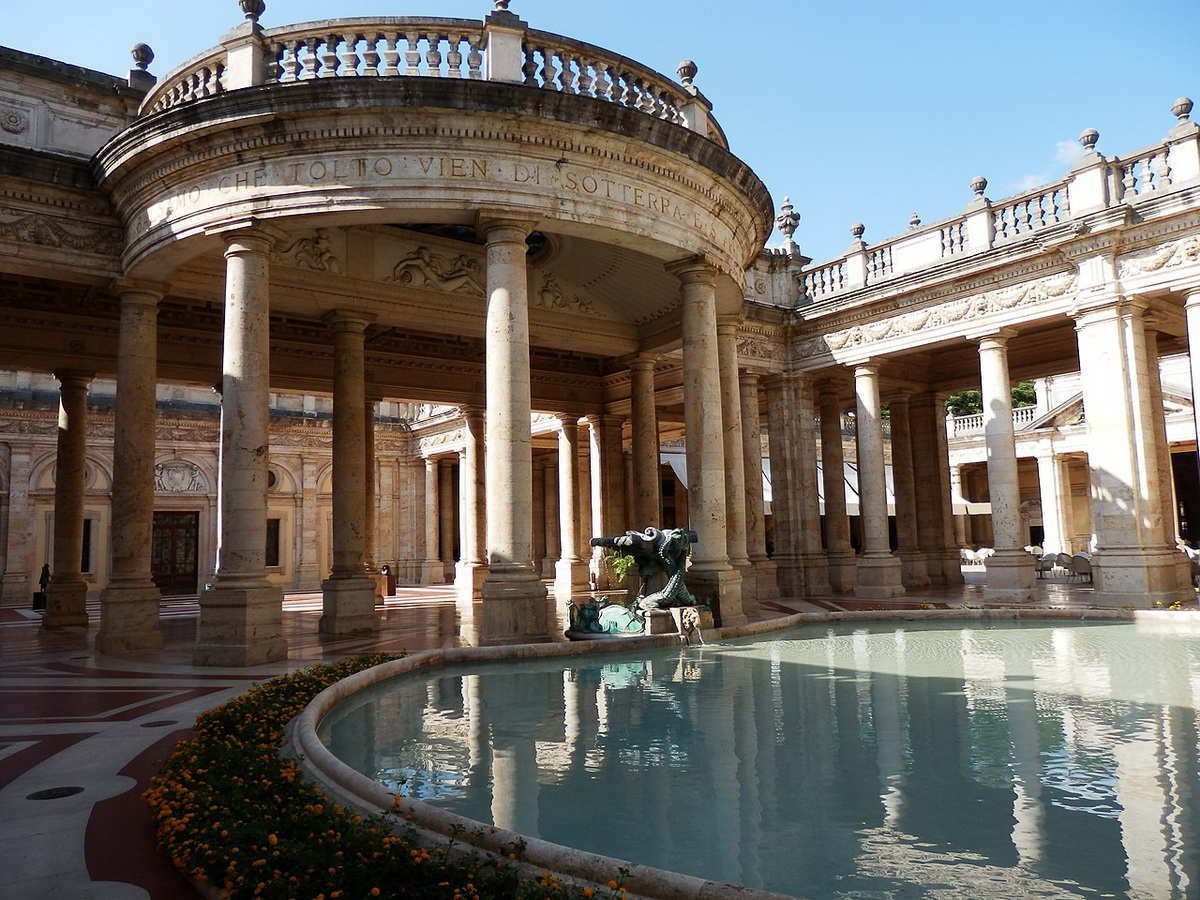
As often happens, the resorts have been, over time, the destination of famous people: musicians, artists and actors. Montecatini wanted to remember them by creating, from Piazza del Popolo to the Tettuccio, a path similar to the street in Hollywood with the famous stars set on the wide pavements, here called ‘Passi di gloria’. You walk around browsing among the studs placed flush on the sidewalks, which bear the name of the character and the year in which he was a guest in Montecatini. Grand Duke Leopoldo opens the parade and is then followed by an impressive number of famous people.
Montecatini Contemporary Art – MO.C.A. – The Town Hall is located in the Royal Palace which dates back to 1783. The Museum of Contemporary Art of Montecatini called MO.C.A. (Montecatini Contemporary Art) inaugurated in 2012. It collects works by world-famous artists such as Pietro Annigoni and Joan Mirò as part of its permanent collection and is often home to temporary thematic exhibitions.
The Liberty in Montecatini – called Art Nouveau in France and Modern Style in England, this floral style with the typical sinuous lines and the many naturalistic ornamental motifs, in Italy was called Liberty style. Galileo Chini, master of Art Nouveau in Italy, characterized the thermal town by transforming it into a true museum of this style of art. The center of Montecatini looks like an open-air art gallery. Starting from Viale Verdi and Piazza del Popolo, going up towards the north you will find the Gambrinus arcades, the Politeama (now Imperial cinema), the town hall and then climbing around the Parco delle Terme with the cinema and the former Excelsior casino, the Tamerici , the Tower up to the Roof. Off the main avenue, other works closely related to Liberty are the Kursaal (restored in 1995) and the luxurious Grand Hotel La Pace.
Montecatini Alto – this is the ancient and original part of the village, an historic center of great charm with its small streets, the square, the Torre di Ugolino, the last remaining of the 25 that dotted the city and its walls before the destruction of 1554, the Church of San Pietro and the promenade that surrounds the whole town, from which you can enjoy the splendid panorama of the Valdinevole.
For more information: https://it.wikipedia.org/wiki/Montecatini_Terme
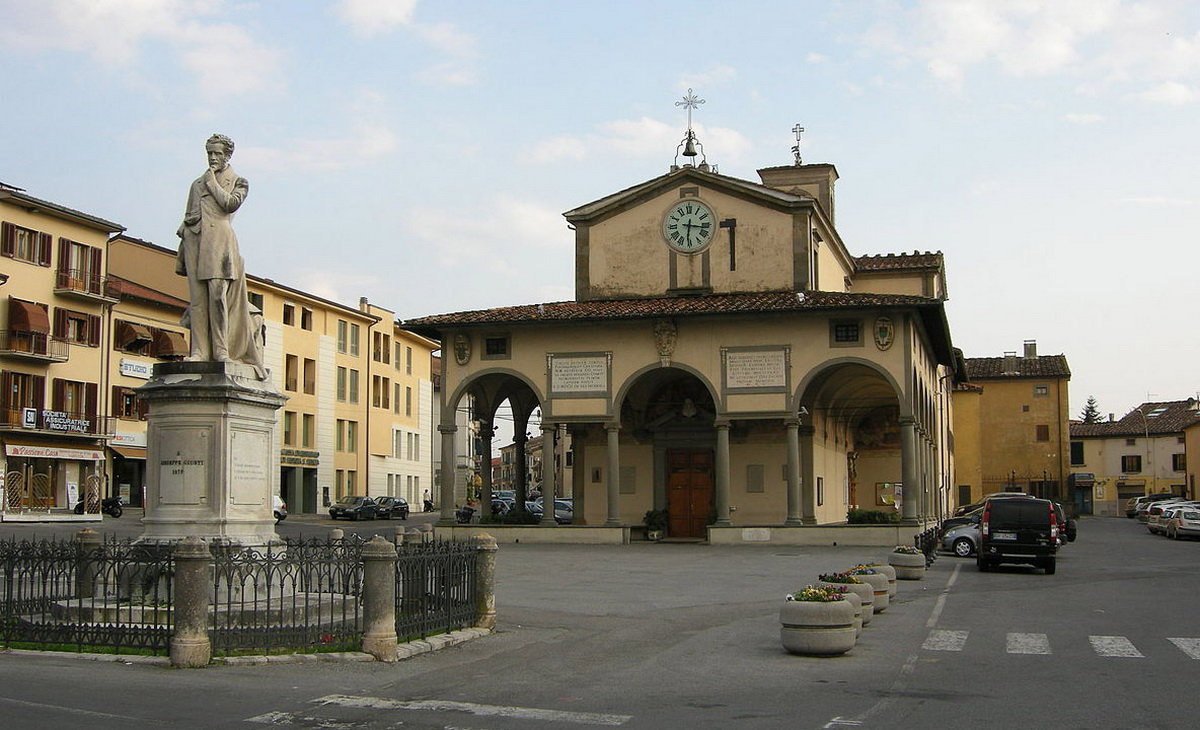
This quiet thermal village can be considered in three distinct areas: the hills of Montalbano, the largely urbanized plain and the wetland of the Fucecchio Marshes, an important natural reserve for the richness of flora and fauna. The town has long been one of the most important Italian footwear districts (since the 1920’s); it underwent an emigration flow with the advent of fascism and then was a place of immigration in the years 1951-1961, thanks to the attraction of the footwear sector. Among the families that emigrated was that of the famous french singer Yves Montand.
Known for its thermal springs, fed by warm waters used for beneficial and relaxing baths. The Giusti cave, the most famous place, is an underground gallery housed in a centuries-old park.
The Sanctuary dedicated to the Madonna della Fontenuova is a work commissioned by the Medici, in particular by the Grand Duke Ferdinando I. Legend has it that a young shepherdess was helped by the Virgin to find the lost flock. There were numerous other apparitions that followed and which aroused the interest of many devotees. To welcome the devotees who went on a devotional path to the sanctuary, the Medici had the Osteria dei Pellegrini built in the main square of the historic center, which has now become the seat of the Museum of the City and the Territory, and collects testimonies on the Valdinievole and on the remediation of the wetland Fucecchio Marshes. It was the seat of the Prisons and the judicial offices until the 1980’s, and has hosted the Municipal Library on the ground floor since its foundation in 1970. On the second floor a cell of the 19th century prisons has been preserved intact, to preserve its memory. historical. Another place of significant historical and artistic interest is the nineteenth-century Villa Martini, home to the Museum of Contemporary Art and the twentieth century.
For more information: https://it.wikipedia.org/wiki/Monsummano_Terme
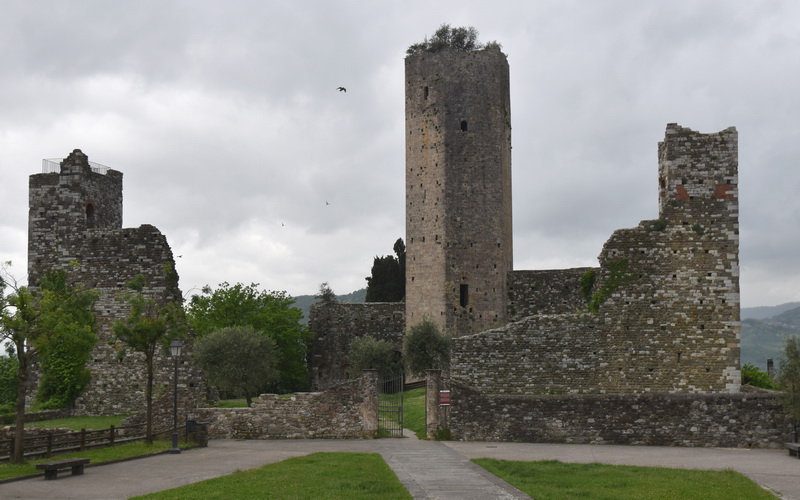 At the gates of Pistoia, this village is characterized by the remains of two fortresses, on opposite sides of the town. One is the Torre del Barbarossa, in limestone while the opposite one is the Castruccian fortress (from the Ghibelline leader Castruccio Castracani) known as Rocca Nuova, which has a particular triangular shape with a hexagonal tower from which the view is extraordinary. In the past, these two structures were connected to each other by a guard walkway that was part of the walls. The existence of a “Door of the gabella” recalls how the place was an ancient customs house. On 19 August, the Feast of San Lodovico is held, with religious rites that culminate with a historical procession and challenges with the arch between the districts competing for the Palio.
At the gates of Pistoia, this village is characterized by the remains of two fortresses, on opposite sides of the town. One is the Torre del Barbarossa, in limestone while the opposite one is the Castruccian fortress (from the Ghibelline leader Castruccio Castracani) known as Rocca Nuova, which has a particular triangular shape with a hexagonal tower from which the view is extraordinary. In the past, these two structures were connected to each other by a guard walkway that was part of the walls. The existence of a “Door of the gabella” recalls how the place was an ancient customs house. On 19 August, the Feast of San Lodovico is held, with religious rites that culminate with a historical procession and challenges with the arch between the districts competing for the Palio.
Since 1399 Pescia was under the dominion of the Republic of Florence. When the Grand Duke raised the village to the status of a city, the “Porta Fiorentina” was dedicated to him, a port with a triumphal arch for access to the city, whose peculiarity is that, having been built only for celebration, it is not connected to the walls. as is normal for a gateway to the city. The chronicles report that the gate was also crossed by Napoleon Bonaparte, when he was engaged in these lands with his troops. It also appears that, to feed the many horses of his army, he ordered the uprooting of mulberry trees and imposed the cultivation of sugar beets, causing considerable economic damage to this territory.
Shortly after passing the Fiorentina gate, leaving Pescia we find ourselves taking the very steep mule track to Uzzano. It is an ancient paved path, of singular beauty, long abandoned, whose care and cleaning was arranged by the Municipality of Pescia following the agreement between various municipalities, including Florence, Pistoia and Lucca, for the exercise associate of functions regarding the enhancement and improvement of the usability of the tourist-devotional itinerary called “Cammino di San Jacopo in Toscana”.
The history of this thermal area has ancient roots but the start seems to be fixed in 1417 thanks to the doctor and scholar Ugolino da Montecatini, father of modern hydrology, in a substantial treatise, he described the virtues of the waters of Monte Catini. The construction of the first plant, called Bagno Regio, was carried out in 1773. Not everyone knows that the current Tettuccio plant takes its name from an ancient pool that was covered by a small canopy.
Between the nineteenth and twentieth centuries, the fame of the healing waters reached its peak. The town is experiencing a period of particular prosperity and is embellished with flower parks and villas, buildings and works of art in Art Nouveau style.
The sources are fed by four springs which, during their journey towards the surface, are enriched with mineral salts which give a characteristic saline flavor; the waters have different characteristics and are divided into strong, medium and weak waters:
- Leopoldina water, (strong water) used for the hydropinic treatment, historical therapy of the Terme di Montecatini, based on the assumption in doses prescribed by the doctor; purifying, with direct action on the intestinal wall, and on all pathologies related to a malfunction of the gastrointestinal system (dyspepsia, constipation, irritable bowel).
- Acqua Regina (medium water) acts on the restoration of bile flow, therefore indicated for dysfunctions of the biliary tract and liver failure.
- Tettuccio water, (weak water) for liver purification; it also has an action on the gastric mucosa by promoting digestion.
- Refreshing water, (weak water) useful for diuresis is also used for mud-balneotherapy.
In Monsummano the only thermal complex is that of Grotta Giusti, the thermal waters of Monsummano are mineral and saline, characterized by the presence of bicarbonate, sulfur, calcium and magnesium, the temperature at the source is 35 ° C. Due to their particular properties, they are used in the treatment of osteo-muscular and respiratory tract diseases, used both in balneotherapy and in inhalation therapies. A true oasis of relaxation and well-being that uses thermal steam to relieve respiratory problems, but also to give relaxation and psycho-physical well-being.
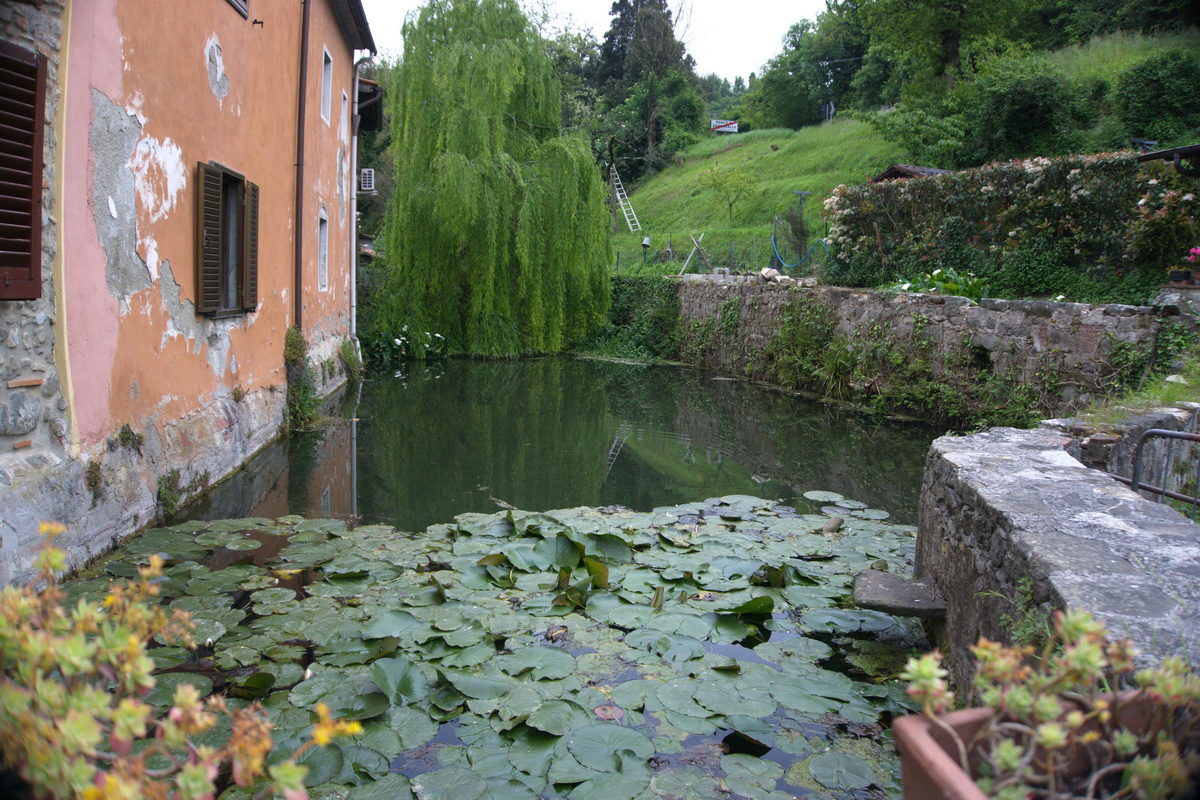 Shortly before the steep climb to Serravalle we meet the ancient village of Gabella Vecchia which housed the municipal customs office as can be seen from some ancient inscriptions placed on the old houses.
Shortly before the steep climb to Serravalle we meet the ancient village of Gabella Vecchia which housed the municipal customs office as can be seen from some ancient inscriptions placed on the old houses.
The suggestive stretch of water now occupied by water lilies once fed and supplied energy to the water wheels of the mills and oil mills and bears the name of Bottaccio del Frantoio. The inhabitants were given the right to draw water without limitations, but only if it was not used by the miller. The withdrawal of the water made to flow into the millstones in order to operate them was forbidden during the working week, but allowed from Saturday evening to the ninth hour of the following Monday, with the permission of the miller. For the entire day of Monday and without limitations it was also allowed to use the water of “La Maggiore”, the main gora of Serravalle, for irrigation.
